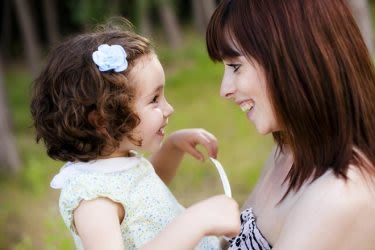Eye and vision problems in preschool children

During the preschool years from ages 3 to 6, your child will be fine-tuning the vision and visual skills that have already developed during their infant and toddler years.
Preschool vision tasks vary with a child's age and activities. For example, some younger preschoolers are learning to ride tricycles or bicylces and mastering the complex eye-hand coordination needed to pedal, steer and watch where they're going at the same time.
Older preschoolers are learning how to integrate vision and body motions (motor skills) by playing sports such as football, netball or cricket, (keep your eye on the ball!), and working on the fine motor skills needed to write their names.
Warning signs
If you have children between the ages of 3 and 6, be aware of these warning signs of possible preschool vision problems:

Timely eye exams help ensure your preschooler's vision is developing properly.
Consistently sitting very close to the TV or holding a book very close
Squinting
Tilting the head to see better
Frequently rubbing eyes, even when not sleepy
Shielding eyes or other signs of trouble with glare
Excessive tearing and
Closing or covering one eye to read, watch TV or see better
Avoiding activities that require good near vision, such as colouring or reading, or good distance vision like ball games
Complaining of headaches across their forehead or simply tired eyes
If your preschooler exhibits any of these signs, schedule an appointment with an optometrist near you.
Refractive errors
The most common preschool vision problems are refractive errors:
Long-sightedness (hyperopia) is common in young children. Significant long sightedness is associated with strabismus and amblyopia ("lazy eye").
Short-sightedness (myopia) is another common preschool vision problem. Myopia causes distant objects to be blurry, like viewing a whiteboard in a classroom.
Astigmatism causes blurry or distorted vision at all distances.
Refractive errors affecting young children typically can be fully corrected with glasses.
The First Eye Exam
Even if your child exhibits no symptoms of a refractive error or other preschool vision problems, they should have an eye examination by the age of 6 months, again at age 2 to 2 and a half, and also prior to starting school.

Having a complete eye examination before your child enters school allows enough time to catch and correct any vision problems that may interfere with learning.
DON'T LET POOR VISION AFFECT YOUR CHILD'S LIFE: Find an optometrist near you and book an appointment.
Children who need vision correction because of refractive errors should have regular eye check-ups throughout their school years to evaluate any changes.
During preschool and the school years, your child's visual system is developing along with the rest of their body, so frequent glasses prescription changes are common.
SEE RELATED: Read more about children's eye exams and how often they are needed.
Make sure your child receives a comprehensive eye exam from an optometrist, not just vision screenings from school screening programs or your GP.
Vision screenings may help spot major problems but they often miss them, too, because they are not comprehensive and and vision exams performed by an optometrist. Vision screenings typically are administered by people who are not trained to detect and diagnose all vision and eye health problems.
Motivating your child to wear spectacles
If your child needs spectacles, ask them to be involved in selecting them. If they help choose the frame, they will be more motivated to wear the glasses.
Also, explain the benefits of the glasses to them, using specific examples — such as, "Your new glasses will help you see the ball better when you play cricket."
Schedule the eye exam and glasses selection at a time that's good for your child. As you know, some kids are more focused early in the day, while others come to life after lunch or an afternoon nap.
Don't visit the optometrist when your child is tired, irritable or hungry.
When choosing frames, select a few styles for your child with the help of an experienced optometrist or optical dispenser. Then give your child the final choice of the glasses they'll wear.
Make the selection process a positive event, discussing how lots of people they know wear glasses, and how they see much better.
Make sure the frames you choose are fitted properly for your child and are comfortable. No one, especially a child, will wear uncomfortable glasses.
Page published on Monday, 16 March 2020






